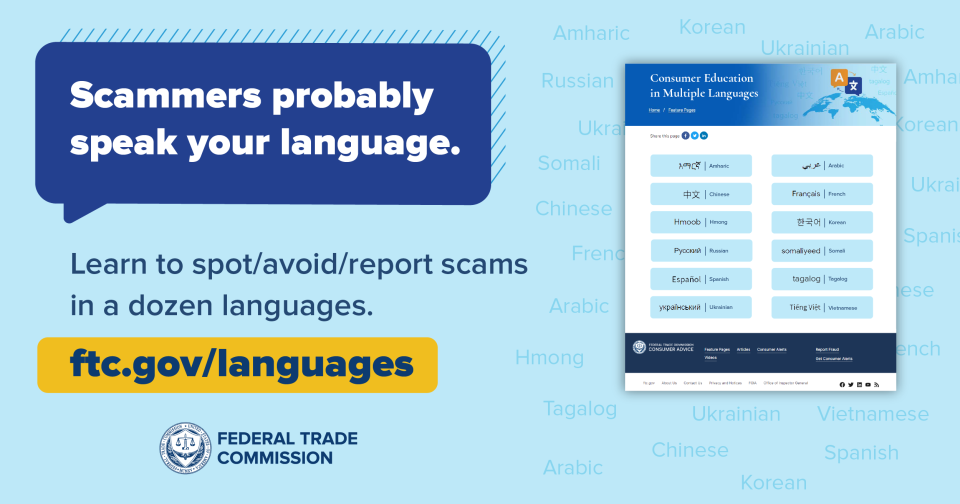Fraud affects every community, and it’s not unusual for scammers to run their scam in the language you speak at home. Now, the FTC has information in a dozen languages to help you spot and avoid those scams: ftc.gov/languages. You’ll find info in Amharic, Arabic, Chinese (Simplified and Traditional), French, Hmong, Korean, Russian, Somali, Tagalog, Vietnamese, and Ukrainian. So, what will you find there?
At ftc.gov/languages, you’ll get all the basics on:
- How to spot and avoid a scam. What are the signs to watch for? What do you do if you spot those signs?
- What to do if you paid a scammer. Or if you think you did. There can be ways to recover your money — sometimes — if you act quickly. Here, you’ll learn what to do.
- What to know if you’re newly arrived in the U.S. Unfortunately, scammers can target people new to U.S. systems and culture, so learn to spot some of the scams related to looking for a job, going through the immigration process, or just figuring out how things work.
You’ll also find graphics in each language to share on social media (please tag @FTC or @laFTC) to help others in your community know how to spot, avoid, and report fraud.
Use the free materials at ftc.gov/languages to spread the word and start conversations with your friends, family, and your community. And use ftc.gov/languages to help encourage the people you know to report the fraud and scams they see at ReportFraud.ftc.gov. And don’t forget to keep up with the latest from the FTC: Sign up to get Consumer Alerts.


If this is doable, I think that many of us would find it useful to have access to instructions as to how to interpret the headers in emails. I understand that the "from" information can be spoofed, however at some stage in the headers there must be indicators as to the actual source of the production. The IP address can reveal some information but usually not enough. In most cases, scam emails seem very lame--with "delete" without further action being the obvious remedy--but not always. Especially in the case of recurring attempts from the same source it would be helpful to know exactly what address to block to prevent re-occurrence in the future.
I've been sucked in two times losing about$1300 and have been close to it other times. They are very clever and believable. Had one the other day from "Microsoft" and I called the phone # feeling very uneasy; luckily I closed iit down. As an 85 year old user, it is very scary.
I'm a native English speaker. When writing a paper on the FTC website, I discovered that only Spanish is linked at the top, even though the FTC provides information in twelve other languages. Considering how often immigrants are targeted by scammers, I feel like this could be changed into a dropdown menu or created as a banner with each language written in the target language. It should not live on the "Features" section of the website. How do you expect people who speak something like Amharic to find it? Please make this change to provide better access to our diverse population. This is an excellent website and great resource. Thank you so much.